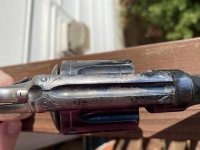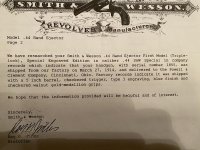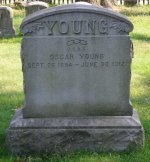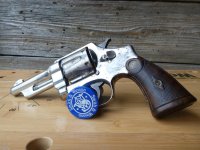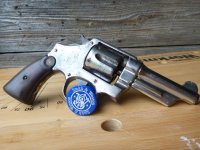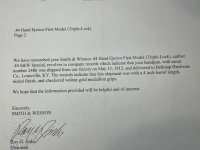Here’s a Type 3 factory engraved Triple Lock revolver. It letters as such, although the engraver is not identified. It letters as presented—blued finish, 5” barrel, checkered trigger—with the exception of the mother of pearl stocks. The letter lists as checkered walnut gold medallion stocks. Likely changed out at the distributor. Shipped to the Powell & Clement Company, Cincinnati, Ohio, 27 March 1914. What is not mentioned is what is engraved on the backstrap: “H. E. B’HYMER, M.D.”. No doubt this was this individual:
U.S., Find a Grave Index, 1600s-Current - Ancestry.com
Shipped a few weeks before Homer Ellsworth B’Hymer’s 39th birthday. Powell & Clement, being in Cincinnati, is about 15 miles from White Tower, Kenton County, Kentucky, where the good doctor resided. Perhaps this was a gift? Incidentally, the only reference to H. E. B’Hymer being a doctor is that which is engraved on the backstrap.
Now, here is where it gets interesting, and I start to hypothesize. The engraving, to me, appears to be that of Oscar Young. The SCSW4 states that Oscar Young worked for Smith & Wesson until 1916. This is clearly in error. Oscar Young died 30 June 1912. Oscar Young (1854-1912) | WikiTree FREE Family Tree
However, I’m smart enough to realize that even headstones can contain faulty information. For example, my own great great grandfather, H P Collins, is buried beneath a stone that gives a date of birth of 1869–7 full years after he was really born. Lest there be any confusion, census records confirm he was really born in 1862. So, a call to the Vital Statistics department of the City of Springfield Massachusetts on Monday confirms he did in fact pass away 30 June 1912, nearly 21 months before this revolver actually was shipped. Cause of death: Valvocard. Heart disease and cerebral hemorrhage , chronic. Today, we would call this valvular heart disease, congestive heart failure. (Of course, cerebral hemorrhage would be acute). Signs of valvular heart disease include chest pain, shortness of breath, fatigu…. Valvular Heart Disease | cdc.gov
So, if one had a Triple Lock one wanted engraved at the factory, what other option was there other than Oscar Young? None come to mind, and, to me, this looks like classic Oscar Young work. A most esteemed member of this forum, who shall remain anonymous, unless he wishes to respond, agrees this is likely the work of Oscar Young, but it took him awhile to come to this conclusion. Simply put, the engraving of this revolver has some stylistic differences and is not quite the quality one comes to expect of Oscar Young.
And here’s a bit more hypothesizing. I’m guessing that Oscar Young was the staff engraver at Smith & Wesson up to his death, or shortly before. If an order came in for a revolver to ship with custom engraving, that was done rather promptly. I have read on the Colt forum that the work of engravers included making dies for barrel addresses, etc, and this would have been done as needed, outside of current orders requiring factory engraving prior to shipment. And yet more hypothesizing: The number of revolvers requiring engraving prior to shipment—e.g., the “demand”, was less than Oscar Young’s output—e.g., the “supply”. So I’m guessing that when Oscar Young did not have a specific order, being the house engraver for Smith & Wesson, he engraved styles that would be most in demand for future sale, this being Type 3 engraving. And, when an order came in for an engraved Triple Lock revolver, it was ready to ship promptly—months or years after the engraving work was done.
Now, back to the observation by esteemed Smith & Wesson forum member, this member being far more knowledgeable than I could ever hope to be. Could it be that this is the last revolver that Oscar Young engraved, and the quality isn’t exemplary, as, at the time of engraving, Oscar Young was fatigued, had shortness of breath, just wasn’t feeling up to snuff? The fact that it shipped a season shy of 2 years after Oscar Young succumbed to these diseases suggests, at the very least, this certainly was one of the last revolvers engraved by Oscar Young.
As for the personalization of the backstrap, engraved with the new owner’s name, that was clearly done after Oscar Young’s demise. Possibly done at Smith & Wesson, but, as the letter doesn’t mention this, I think this is less likely. My guess is that it was done either at the Powell & Clement Company or even at the local jewelers.
As we all want to learn on this forum, feel free to support, modify, or simply bash any and all of my hypotheses.
Despite any criticisms of this revolver, real or imagined, in this post, it’s still simply a fabulous Triple Lock revolver!
U.S., Find a Grave Index, 1600s-Current - Ancestry.com
Shipped a few weeks before Homer Ellsworth B’Hymer’s 39th birthday. Powell & Clement, being in Cincinnati, is about 15 miles from White Tower, Kenton County, Kentucky, where the good doctor resided. Perhaps this was a gift? Incidentally, the only reference to H. E. B’Hymer being a doctor is that which is engraved on the backstrap.
Now, here is where it gets interesting, and I start to hypothesize. The engraving, to me, appears to be that of Oscar Young. The SCSW4 states that Oscar Young worked for Smith & Wesson until 1916. This is clearly in error. Oscar Young died 30 June 1912. Oscar Young (1854-1912) | WikiTree FREE Family Tree
However, I’m smart enough to realize that even headstones can contain faulty information. For example, my own great great grandfather, H P Collins, is buried beneath a stone that gives a date of birth of 1869–7 full years after he was really born. Lest there be any confusion, census records confirm he was really born in 1862. So, a call to the Vital Statistics department of the City of Springfield Massachusetts on Monday confirms he did in fact pass away 30 June 1912, nearly 21 months before this revolver actually was shipped. Cause of death: Valvocard. Heart disease and cerebral hemorrhage , chronic. Today, we would call this valvular heart disease, congestive heart failure. (Of course, cerebral hemorrhage would be acute). Signs of valvular heart disease include chest pain, shortness of breath, fatigu…. Valvular Heart Disease | cdc.gov
So, if one had a Triple Lock one wanted engraved at the factory, what other option was there other than Oscar Young? None come to mind, and, to me, this looks like classic Oscar Young work. A most esteemed member of this forum, who shall remain anonymous, unless he wishes to respond, agrees this is likely the work of Oscar Young, but it took him awhile to come to this conclusion. Simply put, the engraving of this revolver has some stylistic differences and is not quite the quality one comes to expect of Oscar Young.
And here’s a bit more hypothesizing. I’m guessing that Oscar Young was the staff engraver at Smith & Wesson up to his death, or shortly before. If an order came in for a revolver to ship with custom engraving, that was done rather promptly. I have read on the Colt forum that the work of engravers included making dies for barrel addresses, etc, and this would have been done as needed, outside of current orders requiring factory engraving prior to shipment. And yet more hypothesizing: The number of revolvers requiring engraving prior to shipment—e.g., the “demand”, was less than Oscar Young’s output—e.g., the “supply”. So I’m guessing that when Oscar Young did not have a specific order, being the house engraver for Smith & Wesson, he engraved styles that would be most in demand for future sale, this being Type 3 engraving. And, when an order came in for an engraved Triple Lock revolver, it was ready to ship promptly—months or years after the engraving work was done.
Now, back to the observation by esteemed Smith & Wesson forum member, this member being far more knowledgeable than I could ever hope to be. Could it be that this is the last revolver that Oscar Young engraved, and the quality isn’t exemplary, as, at the time of engraving, Oscar Young was fatigued, had shortness of breath, just wasn’t feeling up to snuff? The fact that it shipped a season shy of 2 years after Oscar Young succumbed to these diseases suggests, at the very least, this certainly was one of the last revolvers engraved by Oscar Young.
As for the personalization of the backstrap, engraved with the new owner’s name, that was clearly done after Oscar Young’s demise. Possibly done at Smith & Wesson, but, as the letter doesn’t mention this, I think this is less likely. My guess is that it was done either at the Powell & Clement Company or even at the local jewelers.
As we all want to learn on this forum, feel free to support, modify, or simply bash any and all of my hypotheses.
Despite any criticisms of this revolver, real or imagined, in this post, it’s still simply a fabulous Triple Lock revolver!
Attachments
-
 7E4F9690-84AA-40D4-9CD8-B79A97D563B0.jpg102 KB · Views: 372
7E4F9690-84AA-40D4-9CD8-B79A97D563B0.jpg102 KB · Views: 372 -
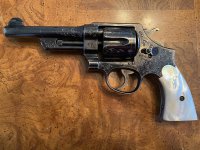 356C4E43-3C17-41E6-B3C7-038B6FBD1F69.jpg104.4 KB · Views: 316
356C4E43-3C17-41E6-B3C7-038B6FBD1F69.jpg104.4 KB · Views: 316 -
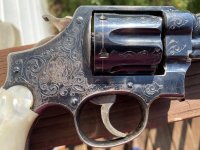 301B5DD8-3329-4928-AC36-60B718096E7F.jpg85.8 KB · Views: 326
301B5DD8-3329-4928-AC36-60B718096E7F.jpg85.8 KB · Views: 326 -
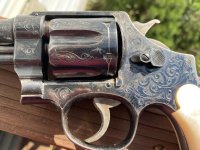 D993C23C-1DB4-4B01-B860-328F12B50B47.jpg84.8 KB · Views: 290
D993C23C-1DB4-4B01-B860-328F12B50B47.jpg84.8 KB · Views: 290 -
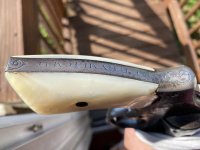 588C248E-9516-4B3D-9BF7-959E40537420.jpg47.8 KB · Views: 276
588C248E-9516-4B3D-9BF7-959E40537420.jpg47.8 KB · Views: 276
Last edited:



